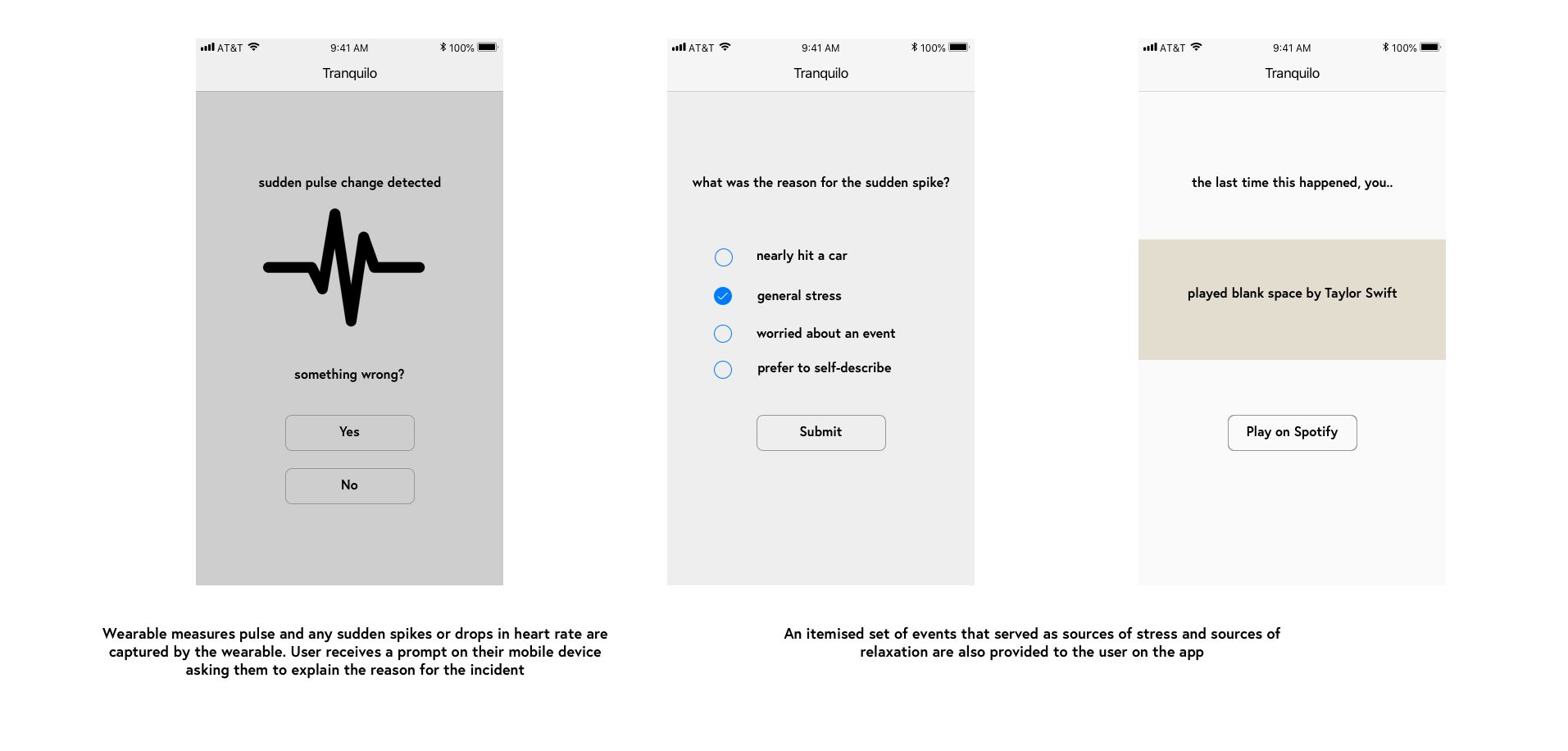Tranquilo
a personal informatics mobile app to measure mood and monitor mental health and well-being

- Project Type: Individual
- Duration: April 2018 — May 2018
- My Role: UX Designer, UX Researcher, Product Manager
Summary
There is research which suggests that our constant exposure to social media these days impacts our moods. This is not just found in adults but children too as referenced in the article. Given these variations in mood, I feel that it is important that people pay more attention to their moods and the impact this has on their emotions on a day-to-day basis.
Enter Tranquilo - a mobile app that helps users measure their moods throughout the day and, in the long-term, seeks to help users gain more control over their moods and how they react to situations.
Product Mission
Tranquilo seeks to make users cognizant of their mood
over the day and through that exercise more control over their reactions to external stimuli
Process
The inspiration for this product came up as an assignment for one of my courses in grad school. The aim of the assignment was to find something that students were not currently tracking or measuring and then coming up with a solution for the same. I've always wanted to measure mood, specifically my reactions to external stimuli and how they affect me, short-term and long-term.

Brainstorming

As I thought of ideas that I would use to measure mood, I came up with three ideas:
- Oral measurement: in this method, the user would speak out their emotions to the app using their mobile phone when asked to by the app. The app would keep track of their mood by asking them to record their moods at various times of the day. Users will then be able to view their responses at the end of the day to see how their moods have changed over the course of the day.
- Written measurement: in this method, the user would write out their emotions to the app in the form of an online diary entry. The app, using sentiment analysis would figure out how the user's moods would change over time and provide feedback to the user about their moods.
- Wearable device: in this method, the user straps on a wearable device on their arm (kind of like a wrist-watch), that measures their pulse and detects any anomalies such as sudden panic or euphoria. This is then displayed to the user at the end of the day through a mobile app so that they can observe their behavior. The app also asks users to record their mood on a scale of 1-10 [10 being happy] at various intervals during the day
User interviews
In order to figure out the best way of going forward, I decided to talk to potential users and ask them how they felt about these ideas. The persons I contacted for interview requests were students and faculty at the University of Michigan. I also spoke to some others such as family members and friends who were not in academics so that I get feedback from people of different backgrounds. Many users liked the idea of a journal or diary entry as they did used to maintain these when they were younger. However, the effort to write a diary entry every day that required them to recollect every incident during the day appeared tedious. Users also expressed some hesitation in speaking out to the phone (oral measurement) in public talking about what they are going through and voicing personal concerns into a device.
Users were very interested in the idea of a wearable. They felt that it would help them achieve what they wanted and yet not in a manner that seemed too conspicuous. They were insistent that the wearable should not prompt them too often asking them how they were feeling and should be able to recognize normal changes in pulse or heart rate such as when one is exercising.
Interviewee Quote
"That sounds great. Wearables are in right now and it would
be interesting in using one that helps me monitor. However, I don't want it to ask me what's wrong when I'm in the middle of
a workout!"
Concept Sketching
The initial sketches of the concept involved what the wearable would look like and some basic features of the app such as what information the app would show the user, what sorts of questions would it ask and how often, and what features would be visible to the user through the app versus the wearable.


Prototype
The protype consisted of sketches for the wearable and what will be seen while using it. Users did not want too much information displayed on the wearable owing to the small screen size. The prototype also included screens for the app which would host detailed information for the user to review at their leisure.

How it works
The wearable device will constantly measure pulse. If the user forgets to wear it for a long period of time, the app on their mobile device will remind them to wear it. When the user wakes up (defined in this scenario as the time when the user first operates their phone in the morning) they will be asked to self-report their mood on a scale from 1-10 (1 being bad-mood and 10 being good-mood). It will be a single input question. Over the course of the day if a user experiences sudden changes in heart rate, the app will trigger a notification asking them to self-report what the reason could have been for that sudden instance of higher pulse. This notification is intended to be triggered a short period (5-7 mins. After the episode) so as to not become a source of stress for the user to self-report. The wearable will help to ensure that this higher rate is not confused with increased physical activity such as biking, running, etc. That is, the app will recognize if the user is involved in heavy physical work and prompt the user to explain their increased heart rate. At the end of the day the user is prompted to have a look at their mood chart for the day. It shows them what caused their heart rate to change and whether that incident was positive or negative.
The app will use machine learning to learn what types of activities calm or de-stress the user and through prolonged usage, it will collect more data and make better decisions to help the user.
Key Features

Design Decisions
One major decision made was to ensure that the user was not prompted right after the incident to ask them why their heart rate rose, but to wait a while and allow the user to de-stess and collect themselves before prompting them. This gives users time to calm themselves down, and also does not serve as an added source of stress.
The use of a wearable and a mobile app was useful because the wearable detected the pulse and had limited display/interaction because of the small screen-size. The mobile app helped the user view detailed information related to their mood and causes
Users were also shown what activities calmed them or resulted in themselves exhibiting positive sentiments so that they could consider indulging themselves in those activities in the future should they want to feel better during a particularly bad day.
Measurement Strategy - analysis of individual measures
In terms of overall effectiveness, while it might not be immediately apparent to the user as to why they have to record events over the day, it will help them understand their mood when the data is shown to them on the app. So, while the immediate effectiveness might not be apparent the final output from the app and the comparison shown will be helpful. Some of the validity issues one might face here are (in line with Unobtrusive Measures [Webb et. al, 1966]):
- Reactive bias by the user - where in the data reported by the user might not be accurate when it is retrospective
- Restrictions on content - where certain types of stigma might provoke the user to only record positive content
- Stability of content over area - where in the user might be affected by causes that are not connected to them. For e.g., students in a university campus concerned over political protests in a campus hundreds of miles away might not have these directly impacting their moods
In terms of usability, the app would score high as with increased use it will help the user track their moods over time and assist them in having better control over their moods. The app will have a simple interface and not disturb the user too often in order to ensure sustained interaction with the system.
Future Work
While the idea itself seems to be very innovative and has piqued the interest of users interviewed, there are some practical hurdles that need to be crossed before proceeding with the app.
- Wearables are in their infancy right now and advanced wearable devices that accurately measure pulse perfectly and at all times are still not affordable enough for the average user
- Data privacy concerns in an app that consumes as much data about the user as this one does tends to worry some users who are concerned about data being held safely and securely within apps
- While the app does support users at some level to measure their mood and identify aspects of their life or incidents that worry them, it cannot act as a replacement for conventional mental health treatment methods such as therapy or counseling.
Based on the above, I feel that the next steps should be to make a working prototype, conduct field research to identify potential pitfalls and hurdles, and then develop a feedback loop to improve the concept.





